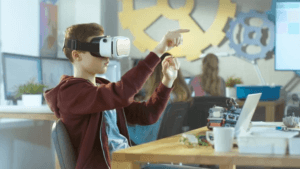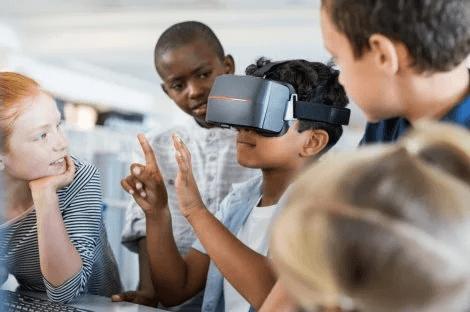Virtual and Augmented Reality in the Classroom: Benefits and Limitations


Written and verified by the social educator Natalia Cobos Serrano
Implementing new technologies in education is a reality nowadays. But despite their numerous advantages, virtual and augmented reality still have a long way to go in the education world.
Keep reading to find out about the benefits and limitations of virtual and augmented reality in the classroom.
How are virtual and augmented reality implemented in education?
Firstly, what are virtual and augmented reality? And how can they be implemented in the education system? According to Augment: Virtual reality (VR) is an artificial simulation generated by a computer of a context or situation in real life, especially stimulating vision and hearing.
In education, virtual reality immerses students in a way that makes them feel they’re experiencing simulated reality directly. Some of the technologies used to create a virtual experience are, for example, Oculus glasses.

On the other hand, augmented reality is a technology that overlaps improvements generated by a computer over an existent reality. This makes it more significant through the ability of interacting with it. Students can use augmented reality through mobile applications, such as those that combine digital components in the real world.
What does this mean in the context of education? It means experiencing the teaching-learning process. This is important when it comes to motivating students, and ultimately, helping them learn in a significant way.
Related to their teaching-learning process, students feel immersed in what they’re doing. This makes them assimilate content and acquire a variety of abilities through experience.
What are the benefits and limitations of VR in the classroom?
Despite the numerous advantages, it seems that products, and ultimately, technology of virtual and augmented reality isn’t yet suitable for all audiences, because it’s not affordable.
Mario Alaguero, teacher at Burgos University and specialist in digital restoration, points out that the main problem of using these technologies in the classroom is the lack of funding in education. He says that it’s important to know how to use these technologies properly, optimizing the resources to create content, such as portable virtual reality.
Also, the fact that their products have a reduced durability leads to a bad reception in schools. This causes teachers and other professionals to lose interest in having them in their classroom.
But the number of benefits outweighs the limitations. It significantly increases student’s motivation because it’s an attractive technology for them, which considerably stimulates their attention and interest in what they’re learning.
Also, making students the main character of their own learning, and showing content in a real and practical way, favors retention and assimilation of content.

Using techniques as cooperative learning through virtual and augmented reality helps students develop a set of necessary social and personal skills – not only for personal and academic life, but also for the social and working future. In particular, using these new technologies helps establish a good educational setting.
Value of virtual and augmented reality
Finally, virtual and augmented reality can be an emotional experience that helps promote important values. Dealing with daily and real situations where students take on a new role, makes them feel empathy. This makes them put themselves in someone else’s shoes and learn from other’s perspectives.
The aim of using virtual and augmented reality in the classroom is to transform the teaching process, improve education quality and create a significant learning experience for students. Despite the fact that nowadays there are still many limitations, it’s worth exploring virtual and augmented reality for all the benefits they can bring to education.
“Thanks to the feeling of presence VR provides, students can learn about a topic through experiencing it. It’s easy to forget that experiencing virtual reality isn’t real: a body really thinks that it’s in a new place. This feeling involves the mind significantly.”
– Nick Babich –
Implementing new technologies in education is a reality nowadays. But despite their numerous advantages, virtual and augmented reality still have a long way to go in the education world.
Keep reading to find out about the benefits and limitations of virtual and augmented reality in the classroom.
How are virtual and augmented reality implemented in education?
Firstly, what are virtual and augmented reality? And how can they be implemented in the education system? According to Augment: Virtual reality (VR) is an artificial simulation generated by a computer of a context or situation in real life, especially stimulating vision and hearing.
In education, virtual reality immerses students in a way that makes them feel they’re experiencing simulated reality directly. Some of the technologies used to create a virtual experience are, for example, Oculus glasses.

On the other hand, augmented reality is a technology that overlaps improvements generated by a computer over an existent reality. This makes it more significant through the ability of interacting with it. Students can use augmented reality through mobile applications, such as those that combine digital components in the real world.
What does this mean in the context of education? It means experiencing the teaching-learning process. This is important when it comes to motivating students, and ultimately, helping them learn in a significant way.
Related to their teaching-learning process, students feel immersed in what they’re doing. This makes them assimilate content and acquire a variety of abilities through experience.
What are the benefits and limitations of VR in the classroom?
Despite the numerous advantages, it seems that products, and ultimately, technology of virtual and augmented reality isn’t yet suitable for all audiences, because it’s not affordable.
Mario Alaguero, teacher at Burgos University and specialist in digital restoration, points out that the main problem of using these technologies in the classroom is the lack of funding in education. He says that it’s important to know how to use these technologies properly, optimizing the resources to create content, such as portable virtual reality.
Also, the fact that their products have a reduced durability leads to a bad reception in schools. This causes teachers and other professionals to lose interest in having them in their classroom.
But the number of benefits outweighs the limitations. It significantly increases student’s motivation because it’s an attractive technology for them, which considerably stimulates their attention and interest in what they’re learning.
Also, making students the main character of their own learning, and showing content in a real and practical way, favors retention and assimilation of content.

Using techniques as cooperative learning through virtual and augmented reality helps students develop a set of necessary social and personal skills – not only for personal and academic life, but also for the social and working future. In particular, using these new technologies helps establish a good educational setting.
Value of virtual and augmented reality
Finally, virtual and augmented reality can be an emotional experience that helps promote important values. Dealing with daily and real situations where students take on a new role, makes them feel empathy. This makes them put themselves in someone else’s shoes and learn from other’s perspectives.
The aim of using virtual and augmented reality in the classroom is to transform the teaching process, improve education quality and create a significant learning experience for students. Despite the fact that nowadays there are still many limitations, it’s worth exploring virtual and augmented reality for all the benefits they can bring to education.
“Thanks to the feeling of presence VR provides, students can learn about a topic through experiencing it. It’s easy to forget that experiencing virtual reality isn’t real: a body really thinks that it’s in a new place. This feeling involves the mind significantly.”
– Nick Babich –
All cited sources were thoroughly reviewed by our team to ensure their quality, reliability, currency, and validity. The bibliography of this article was considered reliable and of academic or scientific accuracy.
- Alaguero, M. (2019). Optimización en proyectos de realidad virtual de bajo presupuesto en la didáctica del patrimonio. Jornadas Aumentame en la Universidad Pontificia de Salamanca. Salamanca.
- Augment. (2019). Virtual Reality vs Augmented Reality. Recuperado de: https://www.augment.com/blog/virtual-reality-vs-augmented-reality/
This text is provided for informational purposes only and does not replace consultation with a professional. If in doubt, consult your specialist.








